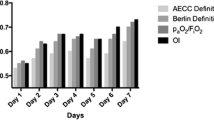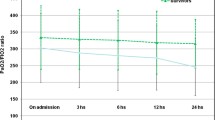Abstract
Both oxygen consumption index (\(\dot V_{O_2 } \)) and simplified acute physiology score (SAPS) are reported to be reliable predictors of the ultimate out-come in critically ill patients. The purpose of this study was to verify whether survivors and nonsurvivors have different \(\dot V_{O_2 } \) and whether the prognostic potency of SAPS can be improved by addition of \(\dot V_{O_2 } \) as a supplemental physiological variable. In 50 mechanically ventilated surgical ICU patients with heterogenous underlying diseases, SAPS was calculated and \(\dot V_{O_2 } \) was determined by continuous 24-h measurement of oxygen consumption. The \(\dot V_{O_2 } \) of survivors and nonsurvivors were not significantly different (p>0.05), which is in contrast to the results of earlier studies. This contrast may be explained by a difference both in methods of \(\dot V_{O_2 } \) and in study populations. SAPS was significantly lower in survivors than in nonsurvivors (p(0.005) and was able to classify the patients correctly into groups of increasing probability of death. However, SAPS failed to be a helpful prognosticator in the individual patient. The addition of \(\dot V_{O_2 } \) to SAPS as a supplemental physiological variable did not substantially improve the prognostic potency. Because a higher \(\dot V_{O_2 } \) did not necessarily indicate a better survival chance, there is no argument for therapeutic interventions aimed exclusively at increasing \(\dot V_{O_2 } \), as suggested previously.
Similar content being viewed by others
References
Abizanda R, Velasco J, Gallego G, Marre P, Valle FX (1986) Severity of illness: at what time is it? Intensive Care Med [Suppl.] 12:169 (Abstr.)
Askanazi J, Carpentier YA, Elwyn DH, Nordenström J, Jeevanandam M, Rosenbaum SH, Gump FE, Kinney JM (1980) Influence of total parenteral nutrition on fuel utilization in injury and sepsis. Ann Surg 191:40
Aubier M, Trippenbach T, Roussos C (1981) Respiratory muscle fatigue during cardiogenic shock. J Appl Physiol 51:499
Baker AR, Evans DH, Prytherch DR, Bell PRF (1986) Haemodynamic assessment of femoropopliteal segment: comparison of pressure and doppler methods using ROC curve analysis. Br J Surg 73:559
Carlsson M, Nordenström J, Hedenstierna G (1984) Clinical implications of continuous measurement of energy expenditure in mechanically ventilated patients. Clin Nutr 3:103
Chang P, Afifi AA, Liu VY, Nishijima H, Weil MH, Shubin H (1975) Prognostic indices for assessment of patients with gramnegative bacteremia and shock. An evaluation of hemodynamic, respiratory and metabolic parameters. In: Urbaschek B, Urbaschek R, Neter E (eds) Gram-negative bacterial infections and mode of endotoxin actions: pathophysiological, immunological and clinical aspects. Springer, Wien New York, p 237
Clowes GHA, O'Donnell ThF, Blackburn GL, Maki ThN (1976) Ehergy metabolism and proteolysis in traumatized and septic man. Surg Clin North Am 56:1169
Dahn MS, Lange P (1982) Hormonal changes and their influence on metabolism and nutrition in the critically ill. Intensive Care Med 8:209
Danek SJ, Lynch JP, Weg JG, Dantzker DR (1980) The dependency of oxygen uptake on oxygen delivery in the adult respiratory distress syndrome. Am Rev Respir Dis 122:387
Dudrick SJ, Drummond RW, Belloso RM, Biskin LC, Dudrick PS, Hedberg AM (1985) Practical considerations affecting the accuracy of indirect calorimetry measurements for nutritional assessment. Clin Nutr [Suppl.] 4:116 (Abstr.)
Duff JH, Grover AC, McLean APH, LaPointe R, Mac Lean LD (1969) Defective oxygen consumption in septic shock. Surg Gynecol Obstet 128:1051
Feenstra BWA, Holland WPJ, Lanschot JJB van, Bruining HA (1985) Design and validation of an automatic metabolic monitor. Intensive Care Med 11:95
Feenstra BWA, Lanschot JJB van, Vermeij CG, Bruining HA (1986) Artifacts in the assessment of metabolic gas exchange. Intensive Care Med 12:312
Fried RC, Bailey PM, Mullen JL, Stein TP, Crosby LO, Buzby GP (1986) Alterations in exogenous substrate metabolism in sepsis. Arch Surg 121:173
Fry DE, Pearlstein L, Fulton RL, Polk HC (1980) Multiple system organ failure. Arch Surg 115:136
Le Gall J-R, Loirat Ph, Alperovitch A, Glaser P, Granthil C, Mathieu D, Mercier Ph, Thomas R, Villers D (1984) A simplified acute physiology score for ICU patients. Crit Care Med 12:975
Halebian P, Robinson N, Barie Ph, Goodwin C, Shires GTh (1986) Whole body oxygen utilization during acute carbon monoxide poisoning and isocapneic nitrogen hypoxia. J Trauma 26:110
Hechtman HB, Grindlinger GA, Vegas AM, Manny J, Valeri CR (1979) Importance of oxygen transport in clinical medicine. Crit Care Med 7:419
Houtchens BA, Westenskow DR (1984) Oxygen consumption in septic shock: collective review. Circ Shock 13:361
Jansen JRC, Versprille A (1986) Improvement of cardiac output estimation by the thermodilution method during mechanical ventilation. Intensive Care Med 12:71
Kho LK, Shoemaker WC (1968) Evaluation of therapy in clinical shock by cardiorespiratory measurements. Surg Gynecol Obstet 127:81
Knaus WA, Zimmerman JE, Wagner DP, Draper EA, Lawrence DE (1981) APACHE — acute physiology and chronic health evaluation: a physiologically based classification system. Crit Care Med 9:591
Knaus WA, Draper EA, Wagner DP, Zimmerman JE (1985) APACHE II: A severity of disease classification system. Crit Care Med 13:818
Van Lanschot JJB, Feenstra BWA, Looijen R, Vermeij CG, Bruining HA (1987) Total parenteral nutrition in critically ill patients: fixed vs tailored caloric supply. Intensive Care Med 13:46
Mela L, Bacalzo LV, Miller LD (1971) Defective oxidative metabolism of rat liver mitochondria in hemorrhagic and endotoxin shock. Am J Physiol 220:571
Rhodes GR, Newell JC, Shah D, Scovill W, Tauber J, Dutton RE, Powers SR (1978) Increased oxygen consumption accompanying increased oxygen delivery with hypertonic mannitol in adult respiratory distress syndrome. Surgery 84:490
Robertson CS, Grossman RG (1985) Energy expenditure in the head-injured patient. Crit Care Med 13:336
Rodriguez JL, Weissman Ch, Damask MC, Askanazi J, Hyman AI, Kinney JM (1983) Morphine and postoperative rewarming in critically ill patients. Circulation 68:1238
Schneeweiss B, Druml W, Graninger W, Laggner A, Lenz K, Kleinberger G (1985) Comparison of oxygen consumption measured by Fick's (\(\dot V_{O_2 } \) Fick) and indirect calometry (\(\dot V_{O_2 } \) MMC) in critically ill patients. Clin Nutr [Suppl.] 4:93 (Abstr.)
Shah DM, Newell JC, Saba ThM (1981) Defects in peripheral O2-utilization following trauma and shock. Arch Surg 116:1277
Shoemaker WC (1971) Cardiorespiratory patterns in complicated and uncomplicated septic shock: physiologic alterations and their therapeutic implications. Ann Surg 174:119
Shoemaker WC (1976) Effects of transfusion on surviving and nonsurviving postoperative patients. Surg Gynecol Obstet 142:33
Shoemaker WC, Appel PL, Waxman K, Schwartz S, Chang P (1982) Clinical trial of survivors' cardiorespiratory patterns as therapeutic goals in critically ill postoperative patients. Crit Care Med 10:398
Shoemaker WC, Appel P, Bland R (1983) Use of physiologic monitoring to predict outcome and to assist in clinical decisions in critically ill postoperative patients. Am J Surg 146:43
Shoemaker WC (1985) Therapy of critically ill postoperative patients based on outcome prediction and prospective clinical trials. In: Vincent JL (ed) Update in intensive care and emergency medicine. Springer, Berlin Heidelberg New York, p 119
Sibbald WJ, Calvin JE, Holliday RL, Driedger AA (1983) Concepts in the pharmacological and non-pharmacological support of cardiovascular function in critically ill surgical patients. Surg Clin North Am 63:455
Siegel JH, Greenspan M, del Guercio LRM (1967) Abnormal vascular tone, defective oxygen transport and myocardial failure in human septic shock. Ann Surg 165:504
Thijs LG, Groeneveld AB, Schneider AJ, Bronsveld W (1985) Hemodynamic aspects of septic shock. In: Vincent JL (ed) Update in intensive care and emergency medicine. Springer, Berlin Heidelberg New York, p 254
Watkins GM, Rabelo A, Plzak LF, Sheldon GF (1974) The left shifted oxyhemoglobin curve in sepsis: a preventable defect. Ann Surg 180:213
Weissman C, Kemper M, Damask MC, Askanazi J, Hyman AI, Kinney JM (1984) Effect of routine intensive care interactions on metabolic rate. Chest 86:815
Wilmore DW, Long JM, Mason AD, Skreen RW, Pruitt BA (1974) Catecholamines, mediator of the hypermetabolic response to thermal injury. Ann Surg 180:653
Wilson RF, Christensen Ch, LeBlanc LPh (1972) Oxygen consumption in critically ill surgical patients. Ann Surg 176:801
Author information
Authors and Affiliations
Rights and permissions
About this article
Cite this article
van Lanschot, J.J.B., Feenstra, B.W.A., Vermeij, C.G. et al. Outcome prediction in critically ill patients by means of oxygen consumption index and simplified acute physiology score. Intensive Care Med 14, 44–49 (1988). https://doi.org/10.1007/BF00254121
Received:
Accepted:
Issue Date:
DOI: https://doi.org/10.1007/BF00254121




